Linda Egenes: What is the main difference between the Transcendental Meditation technique and other meditation techniques, as shown by scientific research?
Dr. Orme-Johnson: Different meditation techniques follow different procedures and have different outcomes, and these effects can be measured. In a paper published in Consciousness and Cognition in 2010, Dr. Fred Travis and Dr. Jonathan Shear reviewed the research on the various meditation techniques and organized them into three categories: Focused Attention, Open Monitoring, and Automatic Self-Transcending.
Linda Egenes: Let’s begin with Focused Attention. What is the procedure for practicing this type of meditation, and what is its purpose?
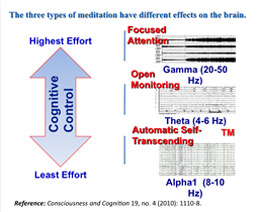 Dr. Orme-Johnson: Focused Attention typically directs the meditator to concentrate on a single thing and to disallow the mind from wandering from it. The focus could be anything: a candle flame or the in-and-out cycle of breathing. The idea is to train your mind to hold its focus on one thing, even though it wants to jump around like a monkey. The goal of this practice is “to gain the ability to center the mind in the present moment.”
Dr. Orme-Johnson: Focused Attention typically directs the meditator to concentrate on a single thing and to disallow the mind from wandering from it. The focus could be anything: a candle flame or the in-and-out cycle of breathing. The idea is to train your mind to hold its focus on one thing, even though it wants to jump around like a monkey. The goal of this practice is “to gain the ability to center the mind in the present moment.”
Brain imaging has identified the various brain areas associated with mind wandering, awareness of distraction, reorienting awareness, and sustained focus. Studies cited in the November 2014 issue of Scientific American suggest that practicing Focused Attention can improve the ability to focus.
Linda Egenes: What about the second category, Open Monitoring?
Dr. Orme-Johnson: During Open Monitoring, a person observes their thoughts and experiences appearing and disappearing and tries to maintain a nonjudgmental attitude towards them. The purpose of Open Monitoring is to develop an emotionally nonreactive response to thoughts and sensations that stream through your mind. By practicing nonjudgmental observation during meditation, the hope is that even outside of meditation, you will be able to catch yourself, to control your spontaneous, emotional reaction.
Neuroimaging studies suggest that Open Monitoring diminishes activity in areas of the brain involved in anxiety. Open Monitoring has been shown to help people deal with symptoms of depression and anxiety and improve sleep patterns, and it is being tested for its ability to help war vets with PTSD.
The term “Mindfulness” is another word for Open Monitoring. However, Mindfulness is also used more broadly to refer to programs involving several techniques, including Focused Attention, Open Monitoring, and Compassion meditations.
“In the fight-or-flight reflex, your heart rate goes up, your respiration rate goes up, major stress hormones, such as cortisol, increase. Research shows that TM has the opposite effect.” —David Orme-Johnson, Ph.D.
Linda Egenes: And the third category, Automatic Self-Transcending, would include the Transcendental Meditation technique.
Dr. Orme-Johnson: Yes, TM is the primary example of Automatic Self-Transcending. The TM technique allows your mind to easily and effortlessly settle inward, through quieter levels of thought, until you experience the most silent and peaceful level of your own awareness—pure consciousness.
The purpose of Automatic Self-Transcending is to enliven a state of consciousness that has beneficial effects for the mind and body. Research shows that when you transcend, when you go to quieter and quieter levels of your mind, the level of biochemical and physiological stress decreases.
Essentially, TM creates the opposite effect of the stress response, the classic fight-or-flight response. In the fight-or-flight reflex, your heart rate goes up, your respiration rate goes up, major stress hormones, such as cortisol, increase. Research shows that TM has the opposite effect: heart rate decreases, respiratory rate decreases, levels of cortisol decrease, and so forth.
Linda Egenes: What about brainwave activity in these three categories of techniques. Has that been studied?
Dr. Orme-Johnson: One of the ways to measure the differences between meditation techniques is to look at the electrical activity in someone’s brain at the time they are meditating. The electrical activity of millions of neurons in the brain create brainwaves, called the electroencephalogram or “EEG” for short. These waves rise and fall at different frequencies, depending on our state of consciousness and what we are doing.
For example, during deep sleep, the EEG has a slow frequency, rising and falling only once every second. In Travis and Shear’s review of current research we can see that the three different meditation procedures produced three distinctly different EEG frequencies.
In Focused Attention medita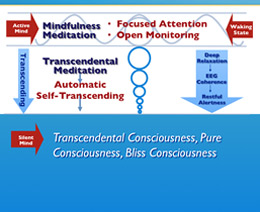 tion the EEG is fast, rising and falling 20 to 30 times a second, which is called beta EEG, or even faster at 30 to 50 times per second, which is called gamma EEG. High frequency (think of a high-pitched tone) is not a restful or calm state, but an active state, and is commonly seen in someone concentrating in a highly focused manner.
tion the EEG is fast, rising and falling 20 to 30 times a second, which is called beta EEG, or even faster at 30 to 50 times per second, which is called gamma EEG. High frequency (think of a high-pitched tone) is not a restful or calm state, but an active state, and is commonly seen in someone concentrating in a highly focused manner.
Open Monitoring is characterized by a slower EEG, oscillating 5 to 8 times a second, called theta. Theta EEG occurs when someone is inwardly preoccupied, such as while reading a novel or solving a mathematical problem, and is no longer aware of the noises or people around them. The thalamus is the central switching area for incoming sensory information, and theta is associated with the thalamus reducing awareness of incoming information.
Linda Egenes: What about research on brainwave activity during TM?
Dr. Orme-Johnson: During Automatic Self-Transcending, as in the Transcendental Meditation technique, you see a middle frequency EEG, 7 to 9 cycles per second, called alpha1, which is characteristic of reduced mental activity and relaxation.
Frontal alpha-wave activity was first discovered by Keith Wallace, Ph.D., and published in Science magazine in 1970. Many subsequent studies have found that frontal alpha-wave activity becomes very coherent or orderly during the TM technique.
For instance, a meta-analysis published in the American Psychological Association’s Psychological Bulletin in 2006 reviewed the EEG research on different types of meditation and cited seven studies showing that alpha EEG coherence increases between the left and right sides of the front of the brain during TM practice, and continues spreading until the whole brain becomes synchronized and coherent.
“The TM technique allows your mind to easily and effortlessly settle inward, through quieter levels of thought, until you experience the most silent and peaceful level of your own awareness—pure consciousness.” —David Orme-Johnson, Ph.D.
Linda Egenes: What is the significance of these EEG patterns?
Dr. Orme-Johnson: It is known that EEG, and particularly alpha coherence (orderliness) organizes the functioning of the brain for memory, creativity, perception, motor behavior—just about everything.
Coherent alpha waves function something like a conductor in an orchestra. When the conductor waves his baton, it provides the timing that organizes all the different components of the orchestra to work together to create a symphony—analogous to the harmonious brain functioning that is created by the coherent frontal alpha waves spreading throughout the brain during TM.
This ability to create more coherent, orderly brain functioning is unique among meditation practices. That’s the real value of the Transcendental Meditation technique: an experience that transforms the way we function, even after meditation.
Linda Egenes: How do brainwaves change when you experience deep transcendence during TM?
Dr. Orme-Johnson: It’s known that when a person is having the experience of pure consciousness, beyond thought, the breath stops for a while, from 10 to 40 seconds. How do we know this? Since the 1970s we’ve asked subjects in experiments to push a button immediately after they have had this experience of pure, silent, unbounded awareness and are thinking thoughts again.
We found that during the periods of respiratory suspension during the TM technique, which correlates with the person’s experience of transcending, the whole brain becomes coherent. The EEG frequencies in all the different areas of the brain synchronize with each other.
Even more significantly, the coherence occurs across all frequencies—alpha, beta, gamma, theta—so it’s broadband coherence. In other words, transcending creates a state of total brain coherence. And this sets a baseline for the brain to be able to integrate.
Having an integrated brain, where the different parts of the brain—and therefore different parts of the body—are in harmonious communication with each other, is perhaps the reason why the TM technique has such powerful healing effects.
Linda Egenes: What are some of those healing effects of TM?
Dr. Orme-Johnson: Systematic reviews and meta-analyses have shown that the reductions of blood pressure in TM practitioners not only can result in reduced use of anti-hypertension drugs; regular TM practice also results in reduced heart attacks and strokes. This has been demonstrated in a comprehensive 10-year study that found 48 percent fewer heart attacks, strokes, and deaths in heart patients who practiced the Transcendental Meditation technique.
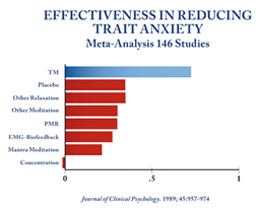 In fact, an American Heart Association (AHA) committee headed by Robert Brook, M.D., evaluated alternative practices for lowering blood pressure and published their findings in the AHA journal Hypertension in 2013.
In fact, an American Heart Association (AHA) committee headed by Robert Brook, M.D., evaluated alternative practices for lowering blood pressure and published their findings in the AHA journal Hypertension in 2013.
In their scientific statement, they concluded that “the Transcendental Meditation technique is the only meditation practice that has been shown to lower blood pressure… all other meditation techniques (including MBSR) received a ‘Class III, no benefit, Level of Evidence C’ recommendation and are not recommended in clinical practice to lower blood pressure at this time.”
“The deep, coherent rest of TM makes your physiology more coherent and less stressed, and on that basis improves everything in your life.” —David Orme-Johnson, Ph.D.
Linda Egenes: It seems like the effortlessness of TM is another way that it differs from other techniques.
Dr. Orme-Johnson: That’s correct. Focused Attention and Open Monitoring require focus and mental effort, which engages the mind at the surface level of thinking. Correct practice of TM is effortless, and the brain is able to experience its own transcendental nature, which is correlated with global coherence or orderliness of the brain.
In a way, TM and mindfulness approaches are opposites. For example, the mindfulness approach to treating PTSD is to train the mind to detach from traumatic memories. It attempts to use volitional control of the mind to change how one reacts to stresses. Mindfulness programs do not provide the deep rest that dissolves stress. Rather, they teach people to change their attitudes and reactions toward stress.
The mechanism of TM, on the other hand, is to put the body and mind into a healing state of deep, coherent rest. When the physiology has a chance to rest so deeply, it releases stress and heals itself. Consequently, the stressful emotions associated with the disturbing memory are softened.
Mindfulness tries to teach you to use your mind to cope with stress, but it doesn’t get rid of it. TM dissolves the stress; it does get rid of it. The deep, coherent rest of TM makes your physiology more coherent and less stressed, and on that basis improves everything in your life.


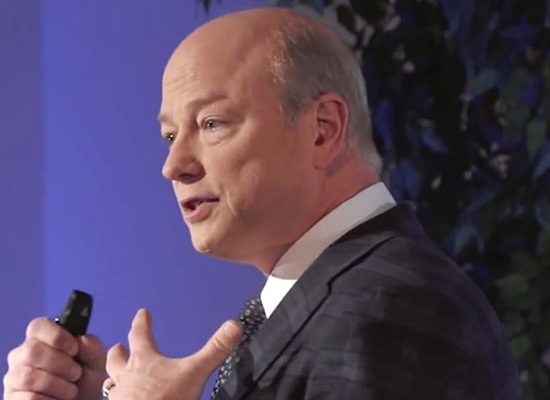
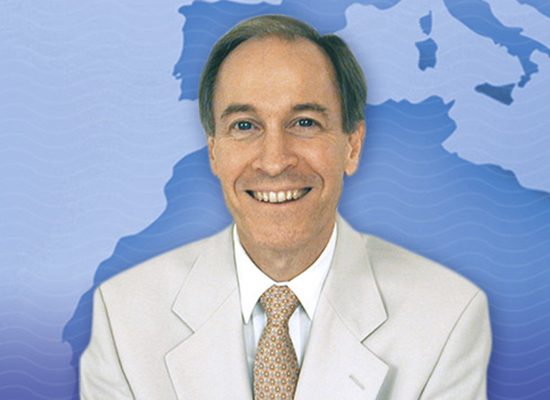
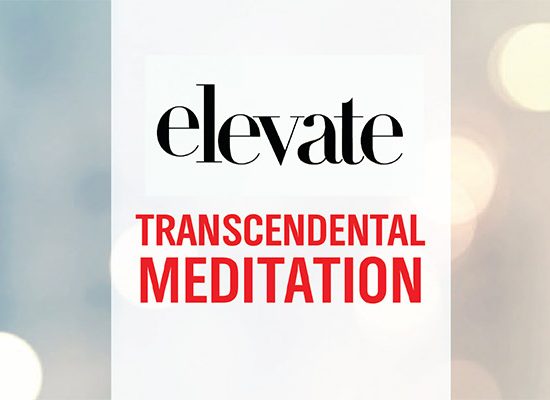
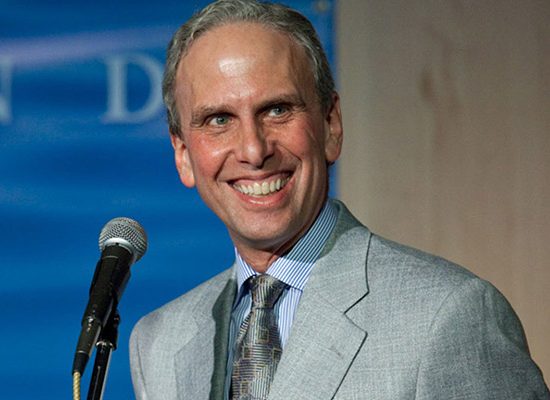
I appreciate the attempt to articulate the differences between different types of meditation!
Please explain how TM is similar and different than focussed attention meditation. As described in this article, the idea of focussed attention is to train the mind to focus on one thing. How is that different than coming back to the mantra when we realize that we have drifted?
I imagine that the amount of effort to stay on the object of attention differ between focussed attention and TM. Is that why you classify it differently? I also imagine that the object of object of attention (ie, mantra vs breath) makes a difference, but might that simply be a variation on the basic process of focussed attention?
Thanks for your response!
Dear Jim, I think both the things you mention are relevant to the differences between Focused Attention meditation and TM: 1) how attention is used, and 2) the object of attention.
1. How attention is used
Focused Attention (FA) meditations attempt to hold attention on a chosen object. They require mental effort, which is verified by neurophysiological research, showing that FA decreases activity in the default mode network (DMN).
TM starts with attention on the object (the mantra), then lets go of it, and the mind effortlessly goes inward towards increasing charm. The effortlessness of TM, in contrast to all other kinds of meditation techniques, both Focused Attention and Open Monitoring, is verified by the fact that TM does not decrease DMN activity.
2. The object of attention
The mantras used in TM are known from the ancient Vedic tradition and from hundreds of scientific studies to have life-supporting effects on all levels of the mind. The effects of meditating on other objects of attention are not known.
The new research by Dr. Fred Travis on the DMN and effortlessness is fascinating. Here is a more detailed reply.
A new neurophysiological study of the Transcendental Meditation technique objectively verifies that it is effortless whereas all other meditation techniques require effort. The study also distinguishes what happens during TM from mind wandering when we just sit with our eyes closed. In addition, this study, along with previous research, gives a neurophysiological insight into what happens when the small relative self evolves into the higher Self during transcendental consciousness and the growth of enlightenment.
Objective evidence of the effortlessness of TM
A new study published in Brain and Cognition by Dr. Fred Travis and Niyazi Parim found that the Transcendental Meditation technique is effortless because it is associated with activity of the Default Mode Network (DMN), the brain system that is active when attention is spontaneously and effortlessly being drawn towards increasing charm.(1) All other meditation techniques (both focused attention and open monitoring types) decrease DMN activity, because focusing attention on a particular thought, object of perception, or stream of thoughts shifts brain activity away from the DMN to other brain systems that support those kinds of object-referral cognitive processes. Neuroscientists have found that the more a cognitive task requires focusing attention and cognitive control, the greater the decreases in DMN activity. Thus, the research on the DMN shows that the TM technique is effortless while all other meditation techniques studied require focusing and controlling the mind.
Alpha EEG, the DMN, and effortlessness
Another aspect of the DMN is that its activity is associated with alpha (8-12 Hz) EEG frequency, the same EEG frequency associated with TM. Specifically, TM is associated with the slower alpha1 (8-10 Hz), which originates in the frontal, executive brain areas, is associated with increased blood flow, and the mental state of restful alertness. This makes sense because restful alertness means an effortless state of inner wakefulness with no focusing or controlling the mind. In contrast, the EEG associated with focused attention meditation is fast EEG gamma (20-50 Hz), which is known to occur while focusing attention on anything, not just while meditating. Open monitoring focuses attention on the stream of thoughts and is associated with theta (4-8 Hz), which is known to occur when one is directing attention inward on thinking, such as solving a mental arithmetic problem.(2) Thus, the unique alpha1 EEG seen during TM is another indication that it is effortless, in contrast to other meditation techniques, which require focused attention and produce EEG signatures associated with mental effort.
Transcending is not mind-wandering, but it does improve broad comprehension and ability to focus attention in activity
A goal of mindfulness, as the name implies, is to be present to the moment, not distracted by ruminating thoughts, paying attention, not spaced out, and not letting the mind wander. Mindfulness techniques strive to achieve this goal by what Dr. Jonathan Shear calls Practice-Makes-Perfect techniques. Mindfulness practices focus attention and do not let the mind wander during meditation in order the strengthen the ability to control attention in activity.(3) Neuroimaging research shows that mindfulness practices do increase the volume of brain areas that are involved in attentional control. It is like strengthening a muscle by practice, so that it is available for use in activity. The decreased DMN activity during mindfulness practices is thus regarded as a sign of success that mindfulness works.
The TM technique, on the other hand, also improves the ability to focus in activity, as well as increasing broad comprehension, creativity, intelligence, and a wide range of other things, but by a completely different mechanism than mindfulness. None of these abilities are practiced during TM. There is no Practice Makes Perfect. In fact Dr. Travis has shown that we transcend the same way from day one of TM as we do after years of practice. Transcending is a reflex, like a knee jerk (somewhat), not something that improves with practice. Dr. Shear classifies TM as a State Enlivening technique, it enlivens a state of brain integration and normalizes stresses, so that when the person comes out into activity they function in the world with a more stress-free and integrated state of the nervous system. It is stress normalization and global brain integration by TM practice that creates global improvements in attentional, perceptual, and cognitive abilities, without practicing any of those things at all!
Now, since sitting with eyes closed and letting the mind wander also is associated with DMN activity, we need to say a word about how TM is not mind wandering. For one thing, during ordinary eyes closed rest, the EEG is alpha2 (10-12 Hz), which is different from the alpha1 of TM. Mind wandering/alpha2 originates in sensory and motor brain areas—whereas TM/alpha1 with frontal executive areas; mind wandering/alpha2 is associated with decreased brain blood flow—whereas TM/alpha1 with increased brain blood flow; and mind wandering/alpha2 indicates idling of the brain—whereas TM/alpha1 is associated with restful alertness.
Travis and Parim also report that the brain changes seen during TM distinguish it from ordinary resting with eyes closed. Changes during TM indicate less internal speech and reduced supervisory oversight of mental activity compared to ordinary resting. This also coincides with the experience that TM is easy and effortless—easier than just sitting with eyes closed!
Chart.
1. Travis F, Parim N. Default Mode Network activation and Transcendental Meditation practice: Focused Attention or Automatic Self-Transcending? Brain and Cognition. 2017;111:86-94.
2. Travis FT, Shear J. Focused attention, open monitoring and automatic self-transcending: Categories to organize meditations from Vedic, Buddhist and Chinese traditions. Consciousness and Cognition. 2010;19(4):1110-8.
3. Shear J. State-enlivening and practice-makes-perfect approaches to meditation. Biofeedback. 2011;39(2):51-5.
4. Maharishi Mahesh Yogi. On The Bhagavad-Gita A New Translation And Commentary: Chapters 1-6. Baltimore: Penguin Books Inc.; 1969.
5. Travis FT, Haaga DAF, Hagelin JS, Tanner M, Arenander A, Nidich SI, et al. A self-referential default brain state: patterns of coherence, power, and eLORETA sources during eyes-closed rest and Transcendental Meditation practice. Cognitive Processing. 2010;11(1):21-30.
6. Badawi K, Wallace RK, Orme-Johnson DW, Rouzeré A-M. Electrophysiologic characteristics of respiratory suspension periods occurring during the practice of the Transcendental Meditation program. Psychosomatic Medicine. 1984;46(3):267-76.
Has anyone publically addressed the fraud perpetuated by Herbert Benson and his “relaxation response?” As I understand it, he was a colleague of Dr. Keith Wallace and participated in early research on TM; but he never learned the technique himself, and decided to invent a technique (thinking the word “one” with every breath exhalation) that he claimed would elicit the same results as TM. He then proceeded to use research on TM to imply that the same results could be experienced by doing his technique. Wasn’t this extraordinarily unprofessional? Why was he allowed to get away with this? Even now — forty years later — you hear doctors on TV (PBS) citing his “research.”
Dr. Benson’s thesis that all meditation and relaxation techniques have the same effect has been thoroughly disproven. Both direct clinical comparisons and statistical meta-analyses based on hundreds of studies indicate that different techniques produce different outcomes. One paper cited 175 studies and 25 reviews from which it concluded that the range of outcomes reflect the different goals and methodologies of different meditation and relaxation approaches.(1) For example, the effects of biofeedback are specific to the system addressed. Electromyographic (EMG) biofeedback reduces muscle tension, whereas blood pressure biofeedback modifies blood pressure. Progressive muscle relaxation leads to general muscle relaxation, whereas EMG biofeedback reduces tension only in the muscles to which feedback is applied.
In 1998, Dr. Ken Walton and I published a review of 10 meta-analyses covering a total of 475 studies which show a four-fold difference in effect sizes among different meditation and relaxation techniques.(2) The Transcendental Meditation technique, for example, is more effective than approaches that are modeled after it, such as Benson’s technique, in reducing anxiety, improving psychological health, and reducing tobacco, alcohol, and drug use. My experience from attending an NIH technology assessment conference was that researchers have lost interest in the relaxation response idea. As I pointed out in my article above, the research on TM, mindfulness, and focused attention meditations is all about how they differ in their goals, procedures, and physiological and behavioral effects.
Benson has been taken to task by the scientific community for multiple instances of citing various research studies as supporting the benefits of the relaxation response, which they, in fact, do not (3, 4). A medical reviewer has pointed out that Benson has never done the basic research necessary to establish the reality of his claims.(5) As for his use of the TM research to support his claims, he has been advised to cease and desist, and he has.
So why do you still hear doctors talking about it on the news? They were probably tragically misinformed while in medical school and aren’t yet up to date. You can find more details about it on my website TruthAboutTM.com.
http://www.truthabouttm.org/utility/showArticle/?ObjectID=1873&find=benson&happ=siteAdministrator
References
1. Lehrer PM, Carr R, Deepa S, al. e. Stress management techniques: are they all equivalent, or do they have specific effects? Biofeedback and Self-Regulation. 1994;19:331-401.
2. Orme-Johnson DW, Walton KG. All approaches to preventing or reversing effects of stress are not the same. American Journal of Health Promotion. 1998;12(5):297-9.
3. Tessman I, Tessman J. Book review of “The Power and Biology of Belief”. Science. 1997;276(369-370).
4. Tessman I, Tessman J. Troubling matter. Science. 1997;278:561.
5. Roush W. Herbert Benson: Mind-body maverick pushes the envelope. Science. 1997;276:357-9.